Stalked hydrangea: how to grow a garden liana?
Petiolate hydrangea is the most unusual and rare type of hydrangea, which is still rarely found in Russian gardens. This is a shrub vine, the length of which can reach 25 meters. In gardens, it is bred as an ornamental flowering plant capable of climbing walls and other vertical supports. Bright green leaves and pleasant scent of flowers can turn it into one of the best decorations for a garden or a summer cottage. What do you need to know about this plant?
Content
- The origin and appearance of hydrangea
- Location on the site
- Planting a petiolate hydrangea
- Garden vine care
- Decorative possibilities of hydrangea
The origin and appearance of hydrangea
Petiolate hydrangea was introduced from East Asia, it is one of the most exotic species. Most often it can be found in China, Japan, Korea, Sakhalin and the Kuril Islands are considered the edge of the range. In our gardens, it appeared relatively recently and is still considered exotic, but this plant is perfectly adapted for Russian conditions and can grow in most areas.
In nature, this vine grows in coniferous forests, it twines around massive trunks fir and oil.
With the help of the formation of adventitious aerial roots, hydrangea is able to rise to a height of more than 25 meters. It is noteworthy that this plant can assimilate nutrients both with the help of the main root located on the ground, and with the help of small air roots.
Petiolate hydrangea has simple cordate or broadly ovate leaves, the diameter of which can reach 10 cm. The leaf petioles are long, up to 8 cm, they are covered with short hairs. The upper part of the leaf is darker than the lower, the thickness of the vines stem is usually no more than 5 mm.
With the beginning of autumn, hydrangea leaves turn bright yellow, in October they fall off.
Hydrangea blooms annually in large inflorescences, the diameter of which can be up to 20 cm. Inflorescences of the corymbose type, in the middle of them are smaller flowers, and along the edges there are large white buds, their diameter reaches 3 cm. The inflorescences can also have a white-pink tint. The blooming hydrangea gives off a strong and very pleasant scent that attracts insects. It is because of the beautiful large buds and lush greenery that it has become widespread as a garden plant.
Location on the site
Anyone who wants to grow petiolate hydrangea on the site should know what conditions must be met.
This is not a particularly demanding plant, but some subtleties need to be considered:
- Soil: moist, drained, constant waterlogging should not be allowed. The acidity of the soil is not particularly demanding, but the presence of peat is desirable. It grows poorly on calcareous soils, it is not recommended to choose them.
- Lighting: it is preferable to plant petiolate hydrangea in open places, it will bloom constantly only in good lighting. It can grow in the shade, but growth will be slow, and the flowers will be small.
- Frost resistance: this is a winter-hardy plant that can withstand the climate of the middle zone without any damage.
Hydrangea can be used as groundcover, since it forms a dense green carpet of a fairly large area.For example, it is very convenient to plant it in a rockery, as it goes well with stones, it can also be placed on an alpine slide. In this case, hydrangea is able to completely braid even large boulders, forming beautiful compositions of leaves and lush flowers. On a flat surface, it also grows quickly enough and can be an interesting solution for a large flower bed.
Another placement option is vertical: this plant will be a wonderful decoration for the walls of the house or for a stone fence.
Interestingly, she does not like mesh fences and grows very slowly on them. But if you choose a pillar, a flat wall or a wide tree trunk as a support, the hydrangea will quickly give lush shoots. With proper regular pruning, you can form a thick carpet that can completely cover the wall, this is an excellent option for a summer cottage fence.
Planting a petiolate hydrangea
Hydrangea can reproduce in two ways: with the help of seeds or with the help of shoots.
- Seeds are planted in containers with fertile soil in the fall, subsequently young shoots are transplanted into open ground in the spring.
- The vegetative method is used more often; for this, green cuttings with one internode are cut. The length of the cutting should be at least 8 cm. When rooting, the plants are watered several times a day and protected from direct sunlight.
Planting is preferable in the spring, in April-May.
Plant in open ground seedlings 2-3 years old are recommended. The distance between plantings should be at least 1 meter. The sequence of actions when planting plants:
- Preparation of the landing pit. Its dimensions are approximately 40x40 cm, the depth is up to half a meter. If the plant needs to be planted in clay soil, it is better to increase the size of the pit, and if we are talking about cultivated soils, then it can be made smaller.
- Drainage layer preparation. The bottom of the pit is covered by about 10 cm with broken brick or gravel, and then a layer of fertile soil 12-15 cm thick is poured on top. Drainage is necessary, otherwise the roots of the plant may rot.
- The root system is carefully straightened in the pit, it is covered with soil. The root collar should be flush with the soil surface.
- Plantings need to be watered abundantly: each plant will require at least 20 liters of water.
- It is recommended to add mulch to the trunks, an organic material to protect the soil. These are sawdust, needles, peat, etc. The use of mulch helps to retain moisture in the soil and protects the root system of plants. In addition, it inhibits the growth of weeds and helps protect crops.
- It is very important to choose the right place for planting: think about where it is most profitable to place the hydrangea on the site so that the green carpet and white fragrant flowers do not go unnoticed.
Garden vine care
Growing a hydrangea is not particularly difficult, it is important to provide it with sufficient watering and properly feed it.
If the summer is dry, the plant should be sprayed with water at least 3 times a week. Water the hydrangea once a week, but abundantly. Each plant requires about 20 liters. In this case, it is recommended to water with a large watering can or a sprinkler so that the roots and soil are moistened evenly.
- At the very beginning of summer or even at the end of May, the plants are fed with a solution of slurry (the ratio should be 1:10), mineral fertilizers must also be applied. For the entire growing season, top dressing is applied 3-4 times. Fertilizers such as superphosphate or nitrophos can be used.
- The autumn soil is additionally fertilized with wood ash. For each square meter of area, there should be about 100 grams.
In the first few years, hydrangea usually grows rather slowly, but then it will quickly begin to give lush shoots.If it is used for vertical gardening, and you want to achieve a large crown, then it is necessary to carry out regular pruning of the vines.
For maximum support coverage, the hydrangea is cut in early spring, leaving only a small part of the branches.
In this case, during the growing season, it grows strongly, giving numerous lateral processes. The stems are periodically tied up, directing their growth in the right direction. This is especially important if you want to create a beautiful green decoration, for example, for a gazebo or for an arch.
In addition to decorative, sanitary pruning is also required: dried or diseased shoots must be periodically removed from the hydrangea.
In general, it is not particularly difficult to care for the petioled hydrangea. Like all vines, it is quite resistant to adverse factors, and with constant care, it will delight you with magnificent greenery and constant flowering.
Decorative possibilities of hydrangea
Hydrangea is an unusually beautiful plant that is actively used in landscape design... With its help, you can originally design a hedge, a gazebo, a pergola, any garden building, since the hydrangea quickly gets used to any conditions, and within a few years after planting it will begin to grow rapidly.
To ensure growth in the correct direction, a wire support can be made on the support, then the vine densely braids the vertical surface.
Although its flowers are usually white, they can be artificially made blue: for this, you can buy a bluing agent at a gardening store or sprinkle the soil around the root of the vine with aluminum sulfate. This is harmless for the plant, but its flowers will eventually acquire an interesting bluish tint.
Such a vine looks very interesting, it can be used to decorate the facade of a house or create decorative compositions on the fence.
Stalked hydrangea is a beautiful, exotic and not particularly demanding plant to care for. All this made her a desirable inhabitant of garden plots.




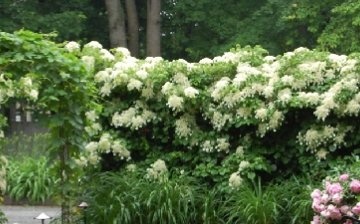
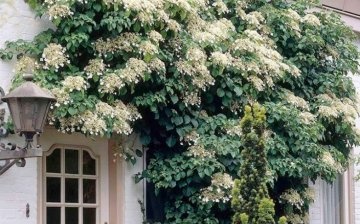
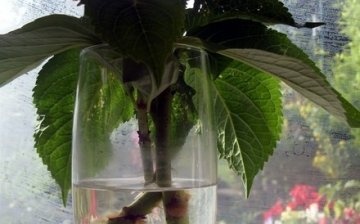
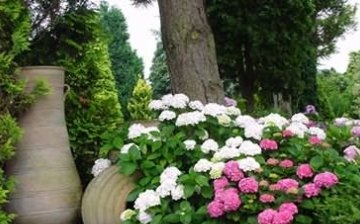





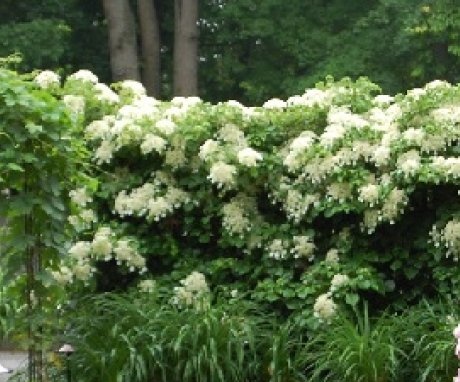
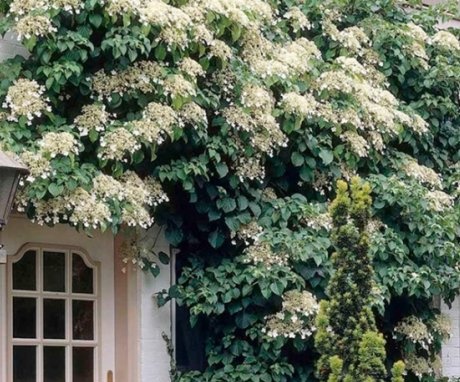
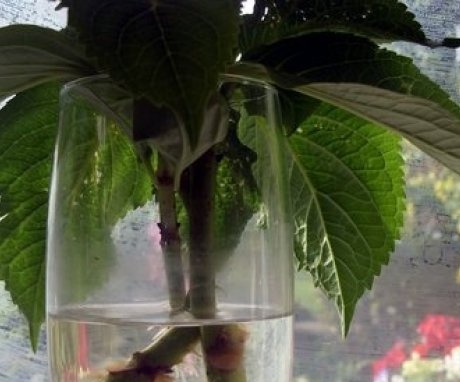
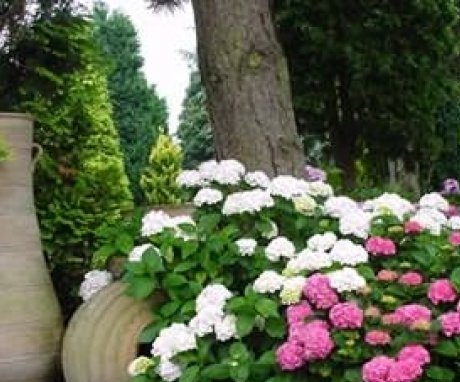
Nowadays, bush hydrangea is very often planted. She blooms with such beautiful huge bunches - a feast for the eyes. But if you also plant a hydrangea-liana, then there will be a fairy tale in general.
For some reason, I have not yet met such a plant. But it looks very beautiful in the photo. Just suitable for decorating a gazebo. I wonder if it is possible to write out a garden liana from the catalog (it is not in the interflora) or is it better to get a stalk somewhere and grow it yourself.